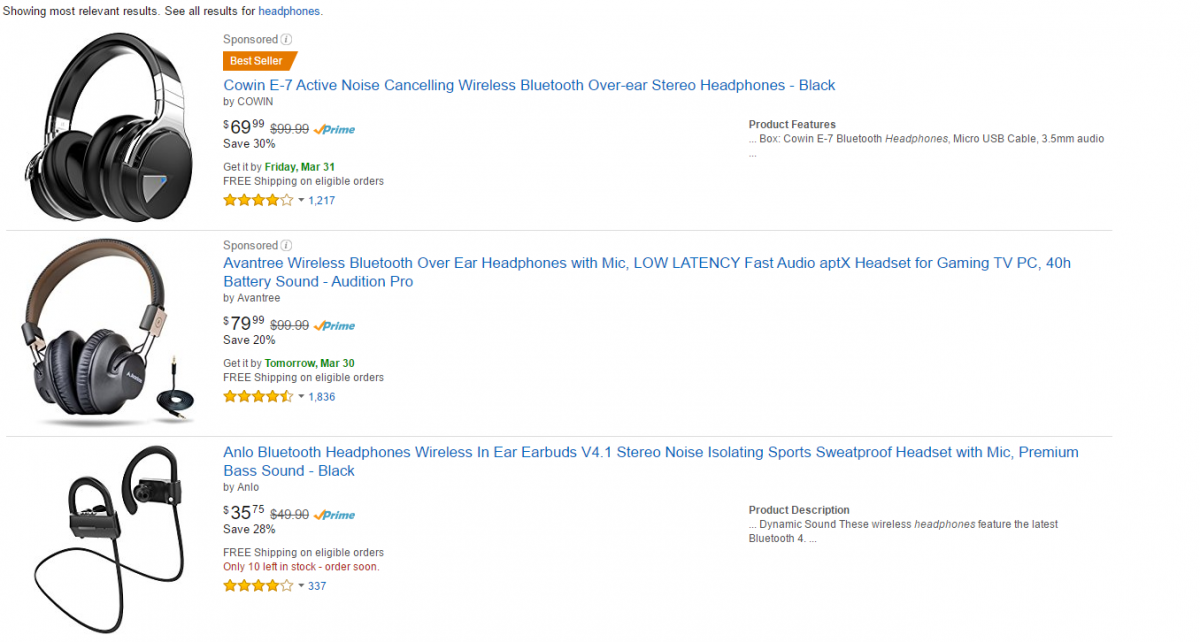Shoppers will only buy your products if they can find them. But with more and more consumers abandoning brick and mortar retailers for the world wide web, winning the online store Search Performance and Optimization battle is fast emerging as a brand’s biggest challenge in the digital shopping era.
Electronics shoppers use the online channel to research, select and validate their purchases, both in store and online. This means long dwell time on your product pages, where your product images and content can make or break the deal.
Below are four ideas that any electronics brand manager can use to increase their online search ranking, and thus improving conversations:
First Page or Bust
According to Millward Brown Digital, less than 30% of Amazon shoppers ever click beyond the first page of search results. And even better than being on the first page of results, is being ‘above the fold”, or the first 1-3 items that appear on a webpage without a user having to scroll down. However, this is easier said than done, as these spots are hotly contested by online only brands, along with upshot internet only brands that are often hyper focused with winning online. Often times major Electronics brands underestimate this first mover advantage online, as previously unknown brands can accumulate thousands of reviews and purchases. Brands that joined Amazon and other websites early can become entrenched in search results. Major companies entering an established category often find themselves having to pay for search spots in order to boost their organic ranking.
Read more about Search on Amazon within the “Definitive Guide to Optimizing Brand Performance on Amazon”.
Example: Amazon US Search Results for “Headphones"

Expect key words to have their top spots taken by sponsored posts: the top 2 are taken for “headphones”
Tracking in Stock – Search Driver
Availability is a major, or the major, driver of search ranking on almost every eCommerce platform. If an item is out of stock retailers will hide it as to not surface items that cannot be bought on the first page of results. At Clavis Insight we have even seen that once an item returns to stock, often times it returns to the search results at a lower level than previously. Therefore, out of stock has two impacts: it removes your item from the buy box and thus limits sales, but constant out of stocks will also harm your search results. This is why the two are interlinked – and daily availability tracking is necessary to maintain strong search results.
Brands Beware: Marketplace is Already Selling your Items – Twisting your way to the top
Brand managers often find they are competition against themselves in Search results. That is, they are competing against third party sellers on Amazon, Walmart, and other websites with a marketplace. Twisting is an important concept to keep in mind when trying to beat out a third party seller on search position. Combining your own product variations – different screen sizes, memory spaces, and colors – onto a single product page at Amazon is necessary for most electronics brands. This allows customers to browse all of your similar products in one stop instead of each individual item coming up in search results.
Amazon first party product pages are always a good place to pick up hints for your Amazon pages. On their Fire Tablet page we see one page for each of the four product colors, two memory sizes, and two offer types. This means a total of 32 products all listed on one page.
A second concept to keep in mind is ASIN merging third party items onto your own product pages, combining duplicate product pages onto your own. This removes product pages you do not manage that clutter search results with misleading information and incorrect pictures. Amazon does not like to see duplicate pages in search results, but it is up to brands to report and merge the appropriate ASIN in order to remove them. However, these pages must be a perfect match. If you are selling a Laptop, and a third party is selling a 2 pack of that same laptop, you may run into issues merging these pages. Take note of what variations of your products are being listed on before trying to merge pages.
You will not be able to eliminate every single third party seller. The best strategy is to variate and twist product options onto your single product page and to maintain strong performance in search results by carefully guarding availability and nurturing a strong presence of reviews.
Voice Search – Preparing for the Future
Amazon Echo is voice-controlled device allows users to shop from home using their voice to order items. Echo has been met with positive reviews, with over 8.6 million estimated devices sold to date. The only way to fully interact to Echo is with your voice through Alexa, Amazon’s AI voice assistant. That creates a new problem: without a “first page” for shoppers to view, how can they find products?
Amazon has introduced the Amazon Choice, or a select recommended product for a given category. Clavis Insight has done an analysis of these products and discovered that they are almost all high performers in their given category. This adds additional pressure for brands to perform well across Ratings & Reviews, Search, Product Content, and more in order to establish themselves as the “Choice” product in a given category. Only then will they beginning to see traffic driven to your items via voice search. In this way, voice search actually adds pressure to brands to excel online, increasing the need for daily stat tracking.
Search is Only One Part of Success
Check out our Perfect Page solutions to get a jump start on creating great content online. You can also check out our latest Electrinics Whitepaper, Adapting Your Consumer Electronics Strategy for eCommerce Expansion to learn more tactics to win in the online channel.




